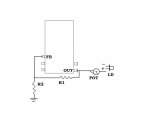Who was attacking who here?
I think that is crystal clear from the contents of your post #26 above.
I also think Ramsey would likely not have made the comments he did if you had not egged-him on to do so, with your dishonest and extremely offensive post instructing him to ignore my advice, and that appears deliberately crafted to pick a fight.
He appears to be fairly new here, so is likely unfamiliar with the instigator who's advice he was following, or have been around long enough to be familiar with this -
http://laserpointerforums.com/f59/should-tech_junkie-unbanned-38798.html
An issue that may need to be re-addressed.
BACK OFF






